Behind the Lines: Alfred Munnings, War Artist
Last year, the Munnings Art Museum presented the most successful exhibition in its sixty– year history. Visitor figures more than doubled, reaching an all-time record of 16,000 people who came to Dedham to see forty-one paintings executed in France by Sir Alfred Munnings during 1918. The paintings were on loan from the Canadian War Museum in Ottawa and it was the first time they had been all together in the United Kingdom in a century. The museum’s landmark exhibition took place a century on from when the pictures were first shown at the Royal Academy in London in 1919; following which Alfred Munnings found international recognition and success. It was a rare opportunity and privilege to present these pictures in the artist’s former home, Castle House, which he bought in 1919.

Exhibition Gallery, Munnings Art Museum, 2019.
The exhibition was the culmination of four years’ work with a newfound transatlantic partner and the museum owes a debt of thanks to the team at the Canadian War Museum and to The Beaverbrook Canadian Foundation for making it all possible.
Creating a Visual Legacy: The Canadian War Memorials Fund
The Canadian War Memorials Fund (CWMF) was established in 1916 and was the initiative of the businessman and politician Sir Max Aitken (later, Lord Beaverbrook). It was set up under the auspices of the Canadian War Records Office to publicise the contribution made by Canadian forces on the Western Front.
The Canadian scheme was one of a number of Allied initiatives designed to employ artists to document the war in what became an unprecedented exercise in the public patronage of art. The clear brief of the CWMF was to record, document, create and memorialise a unique image of the Canadian war effort at home and overseas using four key formats: publications, film, photographs and paintings. It was Beaverbrook’s belief that art had a more lasting cultural value than photographs and by the end of the war the CWMF had employed more than 100 artists. Mostly Canadian and British, they produced nearly 1,000 works of art recording many aspects of war: its violence and its broken landscapes as well as the ordinary everyday life of the soldier behind the lines, and the economic and social activity of the Home Front.
In late 1917 Alfred Munnings was selected by Beaverbrook’s agent Paul Konody to join a group of official war artists working for the Canadian War Memorials Fund. He arrived in France in late January 1918, wearing civilian clothes, with three stretchers (onto which he fixed his canvases) and a box filled with canvases, paper, watercolours, oils and brushes. He was assigned to the Canadian Cavalry Brigade on active service on the Western Front under the command of Major-General J. E. B. Seely. These two men would become lifelong friends. Working behind the lines Munnings recorded in paintings and sketches the daily service life of officers, men and horses within the landscapes of France. He said of the Canadians, “They were the finest and best fellows that I have ever met.”
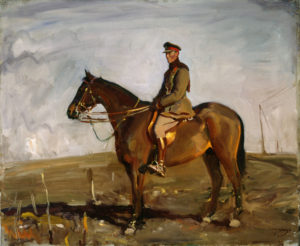
Major General The Right Honourable JEB Seely, 1918, by Sir Alfred Munnings, courtesy the Canadian War Museum, 2020.
A Mobile Fighting Force
The Canadian Cavalry Brigade was formed in January 1915 and went into action May 1915. During the war its soldiers were not only involved in mounted operations but also acted as dismounted infantry in the trenches. The Brigade consisted of the Royal Canadian Horse Artillery, Royal Canadian Dragoons, Lord Strathcona’s Horse and 2nd King Edward’s Horse (later replaced by the Fort Garry Horse).
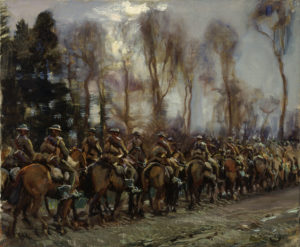
Fort Garrys on the March (I), 1918, by Sir Alfred Munnings, courtesy the Canadian War Museum.
The Brigade had close to 3,000 soldiers at full strength. Over the course of the war, its officers and men were awarded 394 battle honours and decorations including three Victoria Crosses, the Commonwealth’s highest award for valour. While the First World War was an industrial war of artillery, airplanes and chemical agents, horses were crucial to the war effort. Millions of horses served on the Western Front in all armies for both mounted fighting and heavy hauling. They were often underfed and overworked, and died in shocking numbers.
Horses were an enduring passion of Munnings’ life and of his art. He had a keen eye for capturing their sinew, muscle and movement in his paintings. His instinctive understanding of their character and form, and their working relationship with humans, made him an ideal choice as a war artist to work with the cavalry. His sympathetic compositions create a sense of unity between the horses, the soldiers and their surroundings. They show an army and its horses at work; brought to life through the technical mastery of line, tone and colour and the richly textured application of paint.
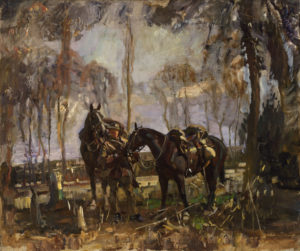
On the Edge of the Wood, 1918, by Sir Alfred Munnings, courtesy the Canadian War Museum
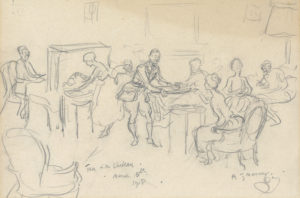
Tea in the Chateau, 1918, by Sir Alfred Munnings, copyright the estate of Sir Alfred Munnings, Dedham.
Munnings also enjoyed the convivial atmosphere of the officers’ mess and was seldom without his pencils and sketchbooks, ready to record off-duty moments in the daily life of soldiers and civilians alike. He was naturally sociable with a keen sense of fun. His eye for detail captured particular moments and the characters and likenesses of people with whom he came into contact.
A Gallant Charge
On the 30th March 1918, the Canadian Cavalry Brigade became involved in the Battle of Moreuil Wood, a commanding position on the riverbank held by the German 23rd Saxon Division. As hundreds of dismounted troopers fought through the wood, 33-year-old Lieutenant Gordon Flowerdew took his mounted squadron of Lord Strathcona’s Horse around its north-east corner. Spotting a large German force in the open, he shouted “It’s a charge, boys, it’s a charge.” Flowerdew’s 75-member squadron rode down on the 300 Germans, who opened up with machine gun, rifle and artillery fire. Most of the troopers and their horses were shot down. The survivors crashed through German lines. Flowerdew was shot in the chest and both thighs and died two days later. For his gallant charge he was posthumously awarded the Victoria Cross. Although a Canadian officer, Flowerdew was born in Norfolk, England and, like Munnings, attended Framlingham College in Suffolk. This is perhaps why Munnings, who was not present at the battle, was inspired to create an heroic depiction of the scene. The action of Flowerdew’s squadron and the larger battle at Moreuil Wood helped to slow the German advance on Amiens, a crucial logistical city.
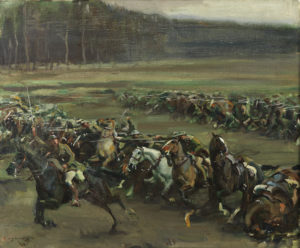
Charge of Flowerdew’s Squadron, 1918, by Sir Alfred Munnings, courtesy the Canadian War Museum
In the Allied retreat of March 1918, following the German spring offensive, Munnings was recalled to London. During the retreat he painted the ruins of a chateau and a barn. The subject matter was an unusual choice as throughout his career Munnings rarely focused on architectural subjects. He emotively recalls of this moment: “… the whole brigade got on the move and marched off through districts of desolation and destruction. We rode through villages and towns where not a house was left intact. All that remained were mounds of rubble, broken walls and the stark ruins of a church … as if shattered by an earthquake.”
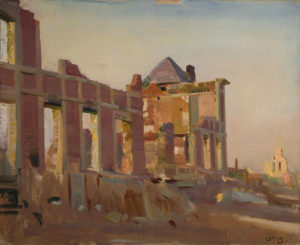
Ruined Chateau at Ennemain, near Athies, 1918, by Sir Alfred Munnings, courtesy the Canadian War Museum.
Supplying the War Machine
In spite of orders to return home, after a chance meeting on the French coast Munnings was persuaded by two senior officers of the Canadian Forestry Corps to accompany them to record the work of the lumber companies. He writes: “I started afresh on another adventure … which had no danger and no risks and which took me into some beautiful parts of France.” The war hardly seems to intrude into his paintings of the forests of Normandy and the Jura that were located far behind the lines.
The Forestry Corps had been formed in 1916 to exploit the timber resources vital for front-line operations and the never-ending demand for duckboards, trench shoring, tunnelling, buildings, railroad construction, airfields and the hundreds of miles of plank roads that snaked across the muddy wastes of Flanders and the Somme. The images of the work of the Forestry Corps are a record and a reminder that an army is made up of numerous service units, many performing important but unsung contributions even though far removed from the heat of the battlefront and Munnings’ paintings of the lumbermen in France are a lasting tribute to the officers and men. He conveys the heavy work and the industrial scale of the Forestry Corps’ operations with loose textured brushwork that has a rough-hewn feel. This technique is characteristic of his pre-war work depicting the East Anglian countryside.
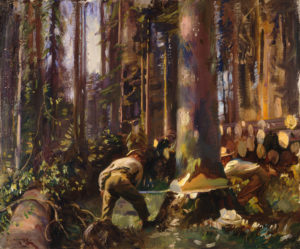
Felling a Tree in the Vosges, 1918, by Sir Alfred Munnings, courtesy the Canadian War Museum
Among the collection of these war paintings from Canada are several landscapes and rural scenes painted by Munnings during his time with the Canadian Forestry Corps. They represent his sympathetic response to the beauty of the French countryside through which he passed in the spring and summer of 1918. Their most striking feature, in an exhibition of war art, is the absence of war itself. They have an atmosphere of tranquillity as if, away from areas of military operations, the reassuring rhythms of everyday life carry on unchanged.
Munnings had a lifelong passion for the landscape, describing the East Anglia of his childhood as a place of “… obscure dreamland hamlets … water-meadows … uplands … and dark belts of woodland …[that] lured and tempted me along road and lane, in and out of deep shadows cast by many a hedge-row oak, by farm or village church.” Throughout his life he brought a restless energy to capturing the mood of a place and had a profound fascination with the effects of light and shadow. This passion and energy found its expression in his images of the French countryside in spite of the war that had brought him there.
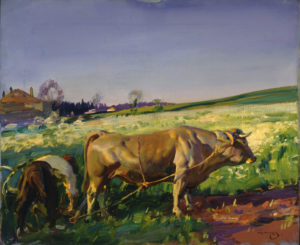
A June Evening in the Jura, 1918, by Sir Alfred Munnings, courtesy the Canadian War Museum
A Reputation Forged in War
Munnings’ portraits of the senior cavalry officers, and his haunting unfinished portrait of a young trooper, testify to his confident mastery of the genre despite the difficult conditions of painting close to the front line and in retreat.

Captain Prince Antoine of Orléans and Braganza 1918, by Sir Alfred Munnings, courtesy the Canadian War Museum.
His first work in France, painted within sight of the enemy, was an equestrian portrait of General “Jack” Seely, the cavalry commander, on his famous horse Warrior. Munnings was as able to capture the likeness and character of a horse as he was of the person mounted on it, and in the 1919 exhibition at the Royal Academy his equestrian portraits were much admired. One such admirer was Princess Alice (grand-daughter of Queen Victoria) who commissioned Munnings to paint a portrait of her husband the Earl of Athlone in uniform on horseback. This was to be the start of many such commissions for the nobility and the wealthy that defined the course of Munnings’ subsequent career. One of the consequences of this was that, in satisfying the demands of patrons, the freely textured character of earlier works was gradually replaced with a less painterly, more polished finish in subsequent portraits. He later reflected: “I have often wondered had there been no 1914-18 war whether painting people on horseback would have absorbed the greater part of my efforts in the years that followed.”
Munnings later recalled that forty-five of his paintings were bought by the Canadian government and exhibited at The Canadian War Memorials Exhibition at the Royal Academy in January 1919. The exhibition was well received and Munnings’ work drew critical acclaim which paved the way for prestigious equestrian commissions in the following years. It was a turning point in his career, transforming him from a successful provincial painter to an artist of international renown who later rose to become President of the Royal Academy.
Timeline
January 1918:
Alfred Munnings arrives at Canadian Army HQ at Hesdin. Travels to Smallfoot Wood to paint portrait of Canadian Cavalry commander General Seely. Based at Bernaville, between Arras and Amiens, painting the cavalry regiments and their horses.
February 1918:
Painting the Cavalry Brigade around Bernaville.
March 1918:
Travelling and painting with the Cavalry Brigade on the move near Peronne, Cambrai and other small towns in the Somme valley close to the front line.21st March Start of the German spring offensive. Munnings is caught up in the fighting retreat of the Allied armies, c. 26th March. For his own safety, Munnings is sent back to Hesdin and then Paris-Plage (new HQ being established near Boulogne) carrying dispatches from General Seely.
April 1918:
Assigned to record the work of the Canadian Forestry Corps in Normandy, painting near Evreux and the forests of Dreux and Belleme.
May 1918:
Painting the work of the Forestry Corps in the Jura region of eastern France, close to the Swiss border. Later in the month he tours the countryside by car, painting landscapes around Labergement, Besancon and Ornans (the birthplace of Gustave Courbet).
June 1918:
Returns to London to put the finishing touches to his work. Forty-five of the pictures acquired by the Canadians.
January 1919:
Paintings exhibited in the Canadian War Memorials Exhibition at the Royal Academy, London.
Words by Brenda Parrish and Charles Proudfoot, introduced and edited by Jenny Hand, Director, the Munnings Art Museum.
A fully illustrated book including all the paintings and drawings which featured in the exhibition is still available to buy from www.munningsmuseum.org.uk
